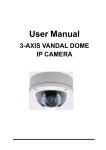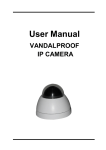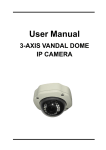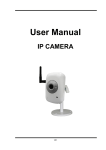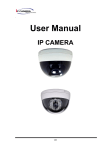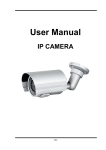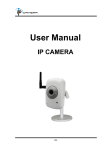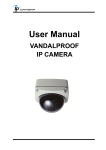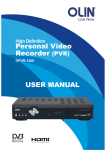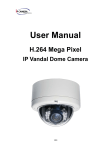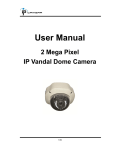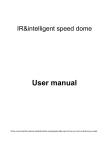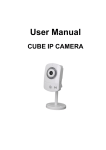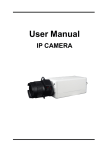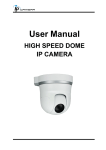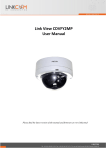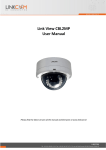Download User Manual - OV Solutions
Transcript
User Manual VANDAL DOME IP CAMERA WARINGS TO REDUCE THE RISK OF FIRE OR ELECTRIC SHOCK, DO NOT EXPOSE THIS PRODUCT TO RAIN OR MOISTURE. DO NOT INSERT ANY METALLIC OBJECT THROUGH VENTILATION GRILLS. CAUTION CAUTION RISK OF ELECTRIC SHOCK DO NOT OPEN CAUTION: TO REDUCE THE RISK OF ELECTRIC SHOCK. DO NOT REMOVE COVER (OR BACK). NO USER-SERVICEABLE PARTS INSIDE. REFER SERVICING TO QUALIFIED SERVICE PERSONNEL. COPYRIGHT THE TRADEMARKS MENTIONED IN THE MANUAL ARE LEGALLY REGISTERED TO THEIR RESPECTIVE COMPANIES. 2 CONTENT I. Preface 4 II. Product Specifications 4 III. Product Installation 7 A. Monitor Setting 7 B. Hardware Installation 8 C. IP Assignment 10 D. Install ActiveX control 12 IV. Live Video 14 V. 17 IP Camera Configuration A. System 18 B. Network 21 C. A/V Setting 30 D. Event List 34 VI. Network Configuration Configuration VII. I/O Configuration 38 VIII. Factory Default 41 IX. Appendix 41 39 I. Preface This IP Camera is a 2M Vandal dome IP camera. It has the web server built in. User can view real-time video via IE browser. IP Camera supports simultaneously H.264, Motion JPEG & MPEG4 video compression and dual streaming which provides smooth and high video quality. IP66 waterproof housing can adapt to outdoor environment. With user friendly interface, it is an easy-to-use IP camera which is designed for security application. II. Product Specifications Main Features: • • • • • • • • • • • • • • • 1/3.2” 2 Megapixel CMOS Sensor Full HD 1080P@30fps real time Digital Noise Reduction Digital Wide Dynamic Range Shutter Speed adjustion Sense Up adjustion Vandal proof IP66 Power over Ethernet available H.264/ M-JPEG / MPEG4 compression Micro SD card backup Support iPhone/Android/Mac Triple Streaming SDK for Software Integration Free Bundle 64ch recording software Specification Hardware CPU RAM Flash Image sensor Lens Type Sensitivity Shutter Time I/O ARM 9 ,32 bit RISC 256MB 16MB 1/3.2” 5 Megapixel CMOS sensor Fish Eye 1.19mm F2.0 1.0 lux @F2.0, 30fps 1 / 5 ~ 1 / 10,000 sec 1 D/I / 1 Relay out 4 Audio Power over Ethernet Power Consumption Operating Temperature Dimensions Weight Network Ethernet Network Protocol G.711(64K) and G.726(32K,24K) audio compression Input : External Mic in Output: 3.5mm phone jack, Support 2-way. Yes 12V DC Power consumption Max:6.24W PoE Power consumption Max:7.48W -10°C ~ 45°C 126mm (W) x 126mm (L) x 100mm (D) 1300g 10/ 100 Base-T HTTP, HTTPS, SNMP, QoS/DSCP, Access list, IEEE 802.1X, RTSP, TCP/ IP, UDP, SMTP, FTP, PPPoE, DHCP, DDNS, NTP, UPnP, 3GPP, SAMBA, Bonjour System Video Resolution Video Adjust Triple Streaming Image snapshot Full screen monitoring Privacy Mask Compression format Video bitrates adjust Motion Detection Triggered action Pre/ Post alarm Security Firmware upgrade Simultaneous connection SD card management Recording trigger Video format Video playback Delete files 1920x1080@30fps, 1280x720@30fps, ,640x480@30fps, 320x240@30fps, 176x144@30fps Brightness, Contrast, Hue, Saturation, Sharpness, AGC, Shutter Time, Sense-Up, D-WDR,Flip, Mirror, Day&Night adjustion ,Noise reduction Yes Yes Yes Yes, 3 different areas H.264/ M-JPEG/ MPEG4 CBR, VBR Yes, 3 different areas Mail, FTP, Save to SD card, Relay out, SAMBA Yes, configurable Password protection, IP address filtering, HTTPS encrypted data transmission, 802.1X port-based authentication for network protection, QoS/DSCP HTTP mode, can be upgraded remotely Up to 10 Motion Detection, IP check, Network break down (wire only), Schedule, D/I AVI, JPEG Yes Yes 5 Client System requirement OS Windows 7, 2000, XP, 2003, Microsoft IE 6.0 or above, Chrome, Safari, Firefox Mobile Support iOS 4.3 or above, Android 1.6 or above. Hardware Suggested Intel Dual Core 2.53G,RAM: 1024MB, Graphic card: 128MB Minimum Intel-C 2.8G, RAM: 512MB, Graphic card: 64MB 6 III. Product Installation A. Monitor Setting 1. Right-Click on the desktop. Select “ Properties” 2. Change color quality to highest (32bit). 7 B. Hardware Installation 1. Connect power adaptor first. 2. Connect IP Camera to PC or network 3. Set up the network configurations according to the network environment. For further explanation, please refer to chapter VI: “Network Configuration for IP Camera”. 4. IP Camera Instruction Remove the dome cover, and you will see the structure as below. 5. Connector Instruction Connect the camera with power and Internet as the picture above. The following picture shows a DC 12V connector for adapter jack plug. About I/O setting, please refer to chapter VII in User Manual: "I/O Configuration" for detail. 8 6. PoE ( Power Over Ethernet)(Optional) 802.3at, 30.0W PoE Switch is recommended Power over Ethernet (PoE) is a technology that integrates power into a standard LAN infrastructure. It enables power to be provided to the network device, such as an IP phone or a network camera, using the same cable as that used for network connection. It eliminates the need for power outlets at the camera locations and enables easier application of uninterruptible power supplies (UPS) to ensure 24 hours a day, 7 days a week operation. Ethernet PoE IP Camera PoE Switch Ethernet Cable Ethernet Cable PoE IP Camera 9 C. IP Assignment 1. You can use the software“IP Installer” to assign the IP address of IP Camera. The software is in the attached CD. 2. The IP installer has two versions of language. Choose one as your need: IPInstallerCht.exe: Chinese version IPInstallerEng.exe: English version 3. There are 3 kinds of IP configuration. a. Fixed IP (Public IP or Virtual IP) b. DHCP (Dynamic IP) c. Dial-up (PPPoE) 4. Execute IP Installer 5. For Windows XP SP2 user, the following message box may pop up. Please click “Unblock”. 6. IP Installer configuration: 10 7. IP Installer will search for all IP Cameras connected on Lan. Click “Search Device” to refresh the result list. 8. Click one of the IP Camera listed on the left side. The network configuration of this IP camera shows on the right side. You may change the “name” of the IP Camera as your preference (eg: Office, warehouse). Change the parameter and click “Submit” . It will apply the change and reboot the Device. 9. Please make sure that the IP address of your PC and IP Camera are on the same subnet. The same Subnet: IP CAM IP address: 192.168.1.200 PC IP address: 192.168.1.100 Different Subnets: IP CAM IP address: 192.168.2.200 PC IP address: 192.168.1.100 To Change PC IP address: Control Panel→Network Connections→ Local Area Connection Properties→ Internet Protocol (TCP/IP) → Properties 10. A quick way to access remote monitoring is to double-click the selected IP Camera listed on “Device list” of IP Installer. An IE browser will be opened. 11 11. If you link to the IP Camera successgully, there pops a box asking you to log in. Please key in the default user name"admin" and password"admin" when you link to the IP Camera for the first time. You can revise the user name and password later. Please refer to Chapter V: "A.2. User Management". D. Install ActiveX control When the first time you view the camera video via IE, it will ask you to install the ActiveX component. If the installation failed, please check the security setting for the IE browser. 1. IE→Tools → Internet Options… → Security Tab → Custom Level… → Security Settings → Download unsigned ActiveX controls→ Select “Enable” or Prompt. 2. IE → Tools → Internet Options… → Security Tab → Custom Level… →Initialize and script ActiveX controls not marked as safe → Select “Enable” or Prompt. 12 1 2 3 4 5 When popup the following dialogue box, click “Yes”. 13 IV. Live Vide Start an IE browser, type the IP address of the IP camera in the address field. It will show the following dialogue box. Key-in the user name and password. The default user name and password are “admin” and “admin”. When the IP Camera is connected successfully, it shows the following program interface. 14 1. 2. : Get into the administration page : Video Snapshot 3. Use the 4-direction arrows and the “+” ”-” zoom icon for PTZ control. 4. Select the camera view vision. If you choose”180D”, the interface will as below. 5. View Mode: Under 360 degree view vision, you may choose “wall” , “ceiling” ,or “desk” according to your camera location. 6. Choose a split screen pattern. 7. Use the bottom to choose one of the split screen that you want to apply the PTZ control. The part you choose is indicated by a red frame arround it. 8. PTZ control: “Step by step” or “Continuous” 9. Show system time, video resolution, and video refreshing rate 10. Adjust image, 1/2x, 1x, 2x 11. Select video streaming source (If in”Video Setting” the streaming 2 setting is closed, this option will not appear here.) 12. Tick the Chatting box to enable the 2-way sound. 13. Show how many people connect to this IP camera. 14. Reply output 15 Double-click the video to switch to full screen view. Press “Esc” or doubleclick the video again back to normal mode. Right-Click the mouse on the video, it will show a pop-up menu. 1. Snapshot: Save a JPEG picture 2. Record Start: Record the video in the local PC. It will ask you where to save the video. To stop recording, right-click the mouse again. Select “Record Stop”. The video format is AVI. Use Microsoft Media Player to play the recorded file. 3. Mute: Turn of the audio. Click again to turn on it. 4. Full Screen: Full-screen mode. 5. ZOOM: Enable zoom-in and zoom-out functions. Select “Enable digital zoom” option first within the pop-up dialogue box and then drag and drop the bar to adjust the zoom factors. 16 V. IP Camera Configuration Click Click to get into the administration page as below. to back to the live video page. 17 A. System 1. System Information a. Server Information: Set up the camera name, select language, and set up the camera time. (i) Server Name: This is the Camera name. This name will show on the IP Installer. (ii) Select language: There are English, Traditional Chinese, and Simplified Chinese to select. When change, it will show the following dialogue box for the confirmation of changing language. b. OSD Setting: Select a position where date & time stamp / text showing on screen. Moreover, click Text Edit can entry to adjust the OSD contents which is Alpha of text. Finally, click Upgrade button to reserve the setting. c. Server time setting: Select options to set up time - “NTP”, “Synchronize with PC’s time”, “Manual”, “The date and time remain the same”. 18 2. User Management IP CAMERA supports three different users, administrator, general user, and anonymous user. a. Anonymous User Login: Yes: anonymous login is allowed No: Username & password are required to access this IP camera b. Add user: Type the user name and password, then click “Add/Set”. 19 c. Click “edit” or “delete” in the user list to modify them. The system will ask you to key in the password in the pop-up window before you edit the user information. 3. System update: a. To update the firmware online, click “Browse…” to select the firmware. Then click “Upgrade” to proceed. b. Reboot system: Re-start the IP camera c. Factory default: Delete all the settings in this IP camera. d. Setting Management: User may download the current setting to PC, or load the previously saved setting. (i) Setting download: Right-click the mouse button on Setting Download → Select “Save AS…” to save current IP CAM setting in PC → Select saving directory → Save (ii) Upgrade from previous setting: Browse → search previous setting → open → upgrade → Setting update confirm → click index.html. to return to main page 20 B. Network 1. IP Setting IP Camera supports DHCP and static IP. a. IP Assignment (i) DHCP: Using DHCP, IP CAMERA will get all the network parameters automatically. (ii) Static IP: Please type in IP address, subnet mask, gateway, and DNS manually. b. IPv6 Assignment: IPv6 is a newer numbering system that provides a much larger address pool than IPv4, which accounts for most of today’s Internet traffic. You can set up IPv6 manually by key in Address, Gateway, and DNS, or enable DHCP to assign the IP automatically. 21 c. Port assignment: (i) Web Page Port: setup web page connecting port and video transmitting port (Default: 80) (ii) HTTP Port:setup HTTPS connecting port (Default:443) d. UPnP (Universal Plug and play): This IP camera supports UPnP, If this service is enabled on your computer, the camera will automatically be detected and a new icon will be added to “My Network Places.” (i) UPnP Port Forwarding: Enable UPnP Port Forwarding can access the Network Camera from the Internet, select this option to allow the Network Camera to open ports on the router automatically so that video streams can be sent out from a LAN. There are three External port can be set, Web Port, Http Port and RTSP port. To utilize of this feature, make sure that your router supports UPnPTM and it is activated. (ii) Note: UPnP must be enabled on your computer. Please follow the procedure to activate UPnP. • open the Control Panel from the Start Menu • Select Add/Remove Programs • Select Add/Remove Windows Components and open Networking Services section • Click Details and select UPnP to setup the service • The IP device icon will be added to “MY Network Places” • User may double click the IP device icon to access IE browser 22 e. RTSP setting (i) RTSP Server: enable or disable (ii) RTSP Port: setup port for RTSP transmitting (Default: 554) (iii) RTSP Start and End Port: in RTSP mode, you may use TCP and UDP for connecting. TCP connection uses RTSP Port (554). UDP connection uses RTSP Start and End Port. f. Multicast Setting (Based on the RTSP Server) Multicast is a bandwidth conservation technology. This function allow several user to share the same packet sent from IP camera. To use Multicast, appoint IP Address and port here. TTL means the life time of packet, The larger the value is, the more user can receive the packet. To use Multicast, be sure to enable the function "Receive Multicast" in your media player. g. ONVIF Choose your ONVIF version and settings. h. Bonjour This function enable MAC systems to link to this IP camera. Key in the name here. 23 i. LLTD If your PC supports LLTD, enable this function then you can check the connection status, properties, and device position(like IP address) of this IP Camera in the network map. 2. Advanced a. Https (Hypertext Transfer Protocol Secure): Https can help protect streaming data transmission over the internal on the higher security level. Https setting: Before setting new request, please remove old secure identification at Http connection type. (i) Created Request: remove secure identification in Created request mode. There is a warning message showing. Please set “Yes” to remove secure identification. (ii) Setting the secure identification and apply it. 24 (iii) Installed Certificate: remove Certificate in .Installed Certificate mode. There will be a warning message to check again. (iv) There are two ways to set Certificate- Install Signed Certificate and Create Self-Signed Certificate. b. SNMP(Simple Network Management Protocol) (i) Enable SNMPv1 or SNMPv2 and write the name of Write Community and Read Community. (ii) Enable SNMPv3, please set Security Name, Authentication Type, Authentication Password, Encryption Type, Encryption Password of Write mode and Read mode. 25 (iii) Enable SNMPv1/SNMPv2 Trap can detect the Trap server. Please set what event need to detect. c. Access List: ”Enable IP address filter” can set IP address which can allow or deny to this camera. There are two options, single and range, for user to set the IP address. d. QoS/DSCP(Quality of Server/Differentiated Services Code-point): DSCP specifies a simple mechanism for classifying and managing network traffic and provide QoS on IP networks. DSCP is a 6-bit in the IP header for packet classification purpose. Please define the reserve for Live Stream, Event / Alarm and Management. e. IEEE 802.1x: IEEE 802.1x is an IEEE standard for port-based Network Access Control. It provides an authentication mechanism to device wishing to attach to a LAN or WLAN. 26 The EAPOL protocol support service identification and optional point to point encryption over the local LAN segment. Please check what version of the authenticator and authentication server support. This camera supports EAP-TLS method. Please enter ID, password issued by the CA, then upload related certificates. 3. PPPoE & DDNS a. PPPoE: Select “Enabled” to use PPPoE. Key-in Username and password for the ADSL connection. Send mail after dialed: When connect to the internet, it will send a mail to a specific mail account. For the mail setting, please refer to “Mail and FTP” settings. 27 b. DDNS: It supports DDNS (Dynamic DNS) service. (i) Enable this service (ii) Key-in the DynDNS server name, user name, and password. (iii) Set up the IP Schedule update refreshing rate. (iv) Click “Apply” (v) If setting up IP schedule update too frequently, the IP may be blocked. In general, schedule update every day (1440 minutes) is recommended (vi) DDNS Status • Updating: Information update • Idle: Stop service • DDNS registration successful, can now log by http://<username>. ddns.camddns.com: Register successfully. • Update Failed, the name is already registered: The user name has already been used. Please change it. • Update Failed, please check your internet connection: Network connection failed. • Update Failed, please check the account information you provide: The server, user name, and password may be wrong. 4. Server setting There are three choices of server types available: Email, FTP and SAMBA. Select the item to display the detailed configuration options. You can configure either one or all of them. a. Mail Setting: To send out the video via mail of ftp, please set up the 28 configuration first. b. FTP: To send out the video via mail of ftp, please set up the configuration first. c. Samba: Select this option to send the media files via a network neighborhood when an event is triggered 29 C. A/V Setting 1. Image Setting a. Privacy Mask For the security purpose, there are three areas can be setup for privacy mask. Click Area button first and pull an area on the above image. Finally, click Save button to reserve the setting. Please refer to the details below for Image setting: b. Image Setting Brightness, Saturation, and Sharpness can be adjusted here. WDR : Enable the function to balance the contrast in the view. DNR: Adjust this option to reduce the noise. 2. Video Setting User may select 2 streaming output simultaneously: Streaming 1 Setting: Basic mode and Advanced mode Streaming 2 Setting: Basic mode, Advanced mode, and 3GPP mode 30 a. Basic Mode of Streaming 1 and Streaming 2: (i) Resolution: There are 5 resolutions can be chosen: 1920x1080, 1280x720, ,640x480, 320x240, 176x144 (ii) Quality: There are 5 levels to choose: Best/ High/ Standard/ Medium/ Low The higher the quality is, the bigger the file size is. It might affect Internet transmitting speed if the file gets too large. (iii) Video Frame Rate: The video refreshing rate per second. The max value will affected by the resolution you choose. (iv) Video Format: H.264, MPEG4, or M-JPEG (v) RTSP Path: Set the RTSP output connecting route b. Advanced Mode of Streaming 1 and Streaming 2: 31 (i) Resolution There are 5 resolutions can be chosen: 1920x1080, 1280x720, ,640x480, 320x240, 176x144 (ii) Bitrate Control Mode There are CBR(Constant Bit Rate) and VBR(Variable Bit Rate) to be choosed. (iii) Video Quantitative The quality adjustment of VBR. You can choose 1~10 compression rate (iv) Video Bitrate The quality adjustment of CBR. You can choose 32kbps~8Mkbps. The higher the value is, the higher the image quality is. (v) Video Frame Rate The video refreshing rate per second. The max value will affected by the resolution you choose. (vi) GOP Size It means “Group of Pictures”. The higher the GOP is, the better the quality is. (vii)Video Format: H.264,MPEG4, or M-JPEG (viii)RTSP Path: RTSP output connecting route 32 c. 3GPP Streaming mode: 3GPP mode fixed setting: 176x144 resolution, 5FPS, MPEG4 format (i) Enable or Disable 3GPP Streaming (ii) 3GPP Path: 3GPP output connecting route 3. Audio: IP Camera supports 2-way audio. User can send audio from IP Camera mic input to remote PC; User can also send audio from remote PC mic to IP Camera’s external speaker. a. Audio from IP camera built-in mic to local PC: select “Enable” to start this function. b. Adjust Volume of audio. c. Check “chatting” in the browsing page, then your voice can be propagated from PC to camera. 33 D. Event List IP Camera provides multiple event settings. 1. Event Setting a. Motion Detection IP CAMERA allows 3 areas motion detection. When motion is triggered, it can send video to some specific mail addresses, transmit the video to remote ftp server, and save video to local SD card. To set up the motion area, click “Area Setting”. Using mouse to drag and draw the area. The same operation for area 2 and 3. b. Rocord File: Choose AVI or JEPG file c. Record Time Setting Pre Alarm and Post Alarm setups for video start and end time when motion 34 detected, I/O, or other devices got triggered d. Network Dis-connected When the network is down, it will save the video to local SD card. This function is only enabled under wire connection. e. Network IP check: Whenever the connection is down, it records the video to SD card. Make sure the video recording is continuous. To use this function, key in the IP address of the PC which has recording software installed. Enable the function of “Save to SD card”, then click “Apply”. The interval of two video files recorded on SD card is fixed with 30 seconds. 2. Schedule a. Schedule: After complete the schedule setup, the camera data will be recorded according to the schedule setup. b. Snapshot: After enable the snapshot function, user can select the storage position of snapshot file, the interval time of snapshot and the reserved file name of snapshot. c. Interval: The interval between two snapshots. 3. I/O Setting 35 a. Input Setting: IP Camera supports input and output. When the input condition is triggered, it can send the video to some specific mail addresses, transmit the video to remote FTP server, trigger the relay, save video to local SD card or to SAMBA. b. Output Setting: "OnOff Switch" means the camera executes the action when triggered. "Time Switch" means the camera executes the action according to the interval you choose after triggered. 4. Log List Sort by System Logs, Motion Detection Logs and I/O Logs. In addition, System Logs and I/O Logs won’t lose data due to power failure. 5. SD card a. Playback Please Insert Micro SD card before use it. Make sure pushing Micro SD card into the slot completely. Click the date listed on this page, and it shows the list of the video. The video format is AVI. Click the video to start Microsoft Media Player to play it. To delete the video, check it, then click "Del". b. SD Management 36 Choose “The 1st day” means the recoding file will be keep one day. Example: It is five o’clock now. Choose “The 1st day”. The files will be kept from five o’clock yesterday to five o’clock today. Note:The use of the SD card will affect the operation of the IP Camera slightly, such as affecting the frame rate of the video. 37 VI. Network Configuration • Configuration 1: a. Internet Access: ADSL or Cable Modem b. IP address: One real IP or one dynamic IP c. Only IP Camera connects to the internet d. For fixed real IP, set up the IP into IP Camera. For dynamic IP, start PPPoE. • Configuration 2: a. Internet AccessL: ADSL or Cable Modem b. IP address: More than one real IP or one dynamic IP c. IP Camera and PC connect to the internet d. Device needed: Switch Hub e. For fixed real IP, set up the IP into IP Camera and PC. For dynamic IP, start PPPoE. 38 • Configuration 3: a. Internet Access: ADSL or Cable Modem b. IP address: one real IP or one dynamic IP c. IP Camera and PC connect to the internet d. Device needed: IP sharing e. Use virtual IP, set up port forwarding in IP sharing. VII. I/O Configuration • I/O Connection Use the terminal block in the camera as below: 39 a. Please connect the COM & N.O / N.C pin (depend on the device) to the external relay (buzzer) device. Or b. Please connect the GND &Alarm pin to the external Trigger Device. • I/O Setup Click I/O Setting from the system setup page via IE, and check “Out1” to enable I/O signal. 40 VIII.Factory Default • To revert back to the default IP address and password, please follow the following steps. • Remove the power, Internet, and the dome cover. Press and hold the button as the picture below. • Connect power to the camera, and do not release the button during the system booting. • It will take around 30 seconds to boot the camera. • Release the button when camera finishes proceed. • Re-login the camera using the default IP (http://192.168.1.200), and user name (admin), password (admin). 41 IX. . Appendix The following is the Micro SD Card recommended: Transcend SanDisk SDHC class4 16GB SDHC class4 32GB SD class4 16GB SD class4 32GB SDHC class6 4GB SDHC class6 8GB SDHC class6 16GB SD class6 4GB SD class6 8GB SD class6 16GB SDHC class10 4GB SDHC class10 8GB SDHC class10 16GB SDHC class4 4GB SDHC class4 8GB SDHC class4 16GB SDHC class4 32GB 42










































